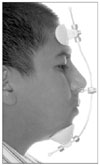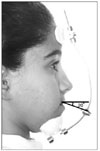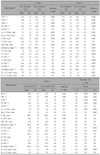1. Ngan P, Hägg U, Yiu C, Merwin D, Wei SH. Soft tissue and dentoskeletal profile changes associated with maxillary expansion and protraction headgear treatment. Am J Orthod Dentofacial Orthop. 1996. 109:38–49.

2. Guyer EC, Ellis EE 3rd, McNamara JA Jr, Behrents RG. Components of class III malocclusion in juveniles and adolescents. Angle Orthod. 1986. 56:7–30.
3. Ellis E 3rd, McNamara JA Jr. Components of adult Class III malocclusion. J Oral Maxillofac Surg. 1984. 42:295–305.

4. Jackson GW, Kokich VG, Shapiro PA. Experimental and postexperimental response to anteriorly directed extraoral force in young Macaca nemestrina. Am J Orthod. 1979. 75:318–333.

5. Kambara T. Dentofacial changes produced by extraoral forward force in the Macaca irus. Am J Orthod. 1977. 71:249–277.

6. Keles A, Tokmak EC, Erverdi N, Nanda R. Effect of varying the force direction on maxillary orthopedic protraction. Angle Orthod. 2002. 72:387–396.
7. Mermigos J, Full CA, Andreasen G. Protraction of the maxillofacial complex. Am J Orthod Dentofacial Orthop. 1990. 98:47–55.

8. McNamara JA Jr, Brudon WL. Orthodontic and orthopedic treatment in the mixed dentition. 1993. Ann Arbor, MI: Needham Press;285–293.
9. Hickham JH. Maxillary protraction therapy: diagnosis and treatment. J Clin Orthod. 1991. 25:102–113.
10. Ishii H, Morita S, Takeuchi Y, Nakamura S. Treatment effect of combined maxillary protraction and chincap appliance in severe skeletal Class III cases. Am J Orthod Dentofacial Orthop. 1987. 92:304–312.

11. Hata S, Itoh T, Nakagawa M, Kamogashira K, Ichikawa K, Matsumoto M, et al. Biomechanical effects of maxillary protraction on the craniofacial complex. Am J Orthod Dentofacial Orthop. 1987. 91:305–311.

12. Nanda R. Biomechanical and clinical considerations of a modified protraction headgear. Am J Orthod. 1980. 78:125–139.

13. Alcan T, Keles A, Erverdi N. The effects of a modified protraction headgear on maxilla. Am J Orthod Dentofacial Orthop. 2000. 117:27–38.

14. Göyenç Y, Ersoy S. The effect of a modified reverse headgear force applied with a facebow on the dentofacial structures. Eur J Orthod. 2004. 26:51–57.

15. Petit H. McNamara JA, Ribbens KA, Howe RP, editors. Adaptations following accelerated facial mask therapy. Clinical alteration of the growing face. 1983. Ann Arbor: Center for Human Growth and Development, University of Michigan;48–59. Monograph no. 14, Craniofacial growth series.
16. Erbay EF, Caniklioğlu CM, Erbay SK. Soft tissue profile in Anatolian Turkish adults: Part I. Evaluation of horizontal lip position using different soft tissue analyses. Am J Orthod Dentofacial Orthop. 2002. 121:57–64.

17. Swlerenga D, Oesterle LJ, Messersmith ML. Cephalometric values for adult Mexican-Americans. Am J Orthod Dentofacial Orthop. 1994. 106:146–155.
18. Takada K, Petdachai S, Sakuda M. Changes in dentofacial morphology in skeletal Class III children treated by a modified maxillary protraction headgear and a chin cup: a longitudinal cephalometric appraisal. Eur J Orthod. 1993. 15:211–221.

19. Kapust AJ, Sinclair PM, Turley PK. Cephalometric effects of face mask/expansion therapy in Class III children: a comparison of three age groups. Am J Orthod Dentofacial Orthop. 1998. 113:204–212.
20. Kajiyama K, Murakami T, Suzuki A. Comparison of orthodontic and orthopedic effects of a modified maxillary protractor between deciduous and early mixed dentitions. Am J Orthod Dentofacial Orthop. 2004. 126:23–32.

21. Baccetti T, Franchi L, McNamara JA Jr. Treatment and posttreatment craniofacial changes after rapid maxillary expansion and facemask therapy. Am J Orthod Dentofacial Orthop. 2000. 118:404–413.

22. Baik HS. Clinical results of the maxillary protraction in Korean children. Am J Orthod Dentofacial Orthop. 1995. 108:583–592.

23. Yüksel S, Uçem TT, Keykubat A. Early and late facemask therapy. Eur J Orthod. 2001. 23:559–568.

24. Merwin D, Ngan P, Hagg U, Yiu C, Wei SH. Timing for effective application of anteriorly directed orthopedic force to the maxilla. Am J Orthod Dentofacial Orthop. 1997. 112:292–299.

25. Proffit WR, Fields HW. Contemporary orthodontics. 1993. St Louis: Mosby;456–459.
26. Haas AJ. The treatment of maxillary deficiency by opening the midpalatal suture. Angle Orthod. 1965. 35:200–217.
27. Kiliçoglu H, Kirliç Y. Profile changes in patients with class III malocclusions after Delaire mask therapy. Am J Orthod Dentofacial Orthop. 1998. 113:453–462.

28. Battagel JM, Orton HS. Class III malocclusion: the post-retention findings following a non-extraction treatment approach. Eur J Orthod. 1993. 15:45–55.

29. Macdonald KE, Kapust AJ, Turley PK. Cephalometric changes after the correction of class III malocclusion with maxillary expansion/facemask therapy. Am J Orthod Dentofacial Orthop. 1999. 116:13–24.

30. Ngan P, Wei SH, Hagg U, Yiu CK, Merwin D, Stickel B. Effect of protraction headgear on Class III malocclusion. Quintessence Int. 1992. 23:197–207.




 PDF
PDF ePub
ePub Citation
Citation Print
Print











 XML Download
XML Download